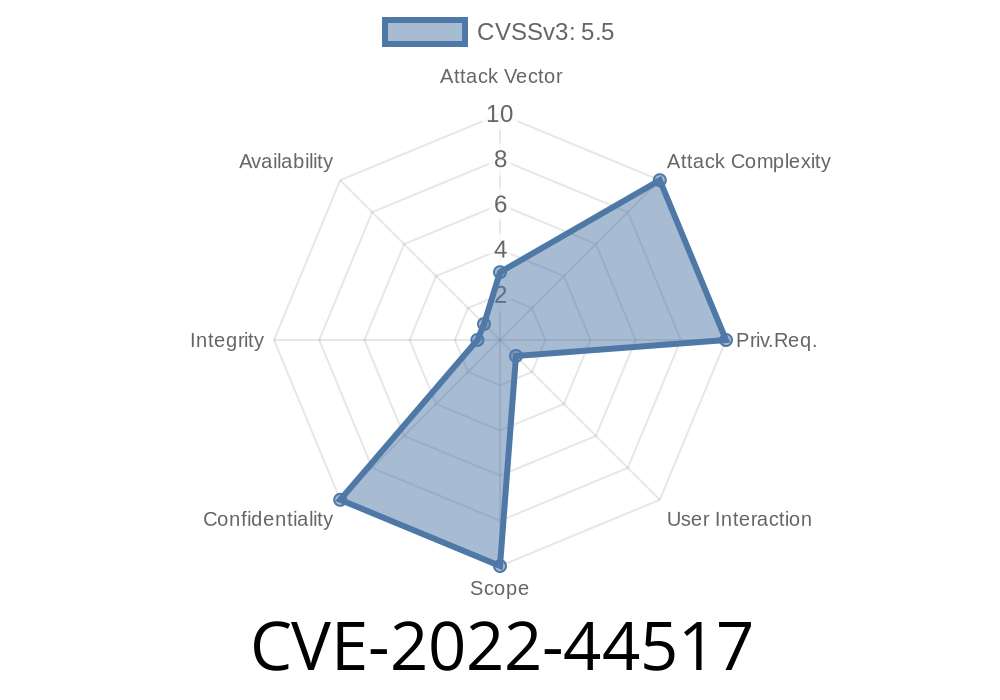Adobe Acrobat Reader DC is one of the most widely used PDF reader applications in the world. With millions relying on it for everyday document viewing, any security issue can have widespread consequences. In late 2022, CVE-2022-44517 surfaced as a notable vulnerability affecting Acrobat Reader DC version 22.001.20085 and earlier, as well as older streams (20.005.3031x and 17.012.30205 and earlier).
This article explains what CVE-2022-44517 is, how attackers could exploit it, and what users and administrators should do to stay secure.
What is CVE-2022-44517?
CVE-2022-44517 is an out-of-bounds read vulnerability that appears when Acrobat Reader DC parses a specially crafted file (typically a PDF). When such a file is opened, Acrobat could read memory beyond the bounds of a buffer allocated for the file. This flaw allows an attacker to access parts of memory they shouldn’t have access to, potentially exposing sensitive data, and in some cases, bypassing key security protections like ASLR (Address Space Layout Randomization).
If combined with other bugs, may allow full control over the affected computer.
- The attack only requires the target to open a malicious PDF file — a common attack vector sent via email, messaging apps, or downloads.
Exploitation Details
While details are not fully public, the pattern is usually the same across Adobe out-of-bounds reads.
1. Attacker creates a malicious PDF: Using knowledge of how Acrobat parses certain PDF objects, attackers craft invalid inputs that cause Acrobat to read past the end of a memory structure.
User opens the PDF: No code executes by default. But opening the file triggers the bug.
3. Memory leakage: The bug can leak application memory, including memory addresses (helpful for further exploitation).
4. Bypassing ASLR: If attackers find out where crucial libraries are loaded, it’s much easier to build a working attack that executes their code later on.
Example Scenario
Let’s say Acrobat expects a stream of image data to be 512 bytes long. An attacker places only 400 bytes but tricks the parser into trying to read 512 bytes, causing Acrobat to read 112 bytes past the intended buffer. This extra data could contain sensitive information or pointers that help build a full exploit.
Here’s a simplified Python snippet showing what not to do (vulnerable approach)
def parse_image(stream):
buffer = stream.read(512)
# ... Later expects buffer to always contain 512 bytes
pixel = buffer[511] # Out-of-bounds if stream provides less data
A safe version should check the length before accessing
def parse_image(stream):
buffer = stream.read(512)
if len(buffer) < 512:
raise ValueError("Image data incomplete")
pixel = buffer[511]
Demonstration (Proof of Concept)
Because distributing real malicious PDFs is dangerous and unethical, we can only outline what a proof of concept might do.
Trigger Parse: When opened, Acrobat’s internal parser reads beyond the allocated buffer.
- Observe Memory Leak: A researcher might notice extra bytes appear inside Acrobat’s output or in a crash report, leaking sensitive memory.
Security researchers use fuzzers, like PDF Fuzz, to automatically generate such malformed files and find these vulnerabilities.
For more about exploiting out-of-bounds reads in PDF readers, see this DEF CON talk:
"Breaking the Reader: Adobe Acrobat Exploitation"
Recommendations
1. Update immediately: Adobe has issued patches. Visit the Adobe Security Bulletin APSB22-56 for official updates.
References
- NVD – CVE-2022-44517 Details
- Adobe Security Bulletin (APSB22-56)
- Mozilla PDF.js Issue 10966 (fuzzing PDF readers)
- DEF CON Talk Slides: Breaking the Reader
Final Thoughts
CVE-2022-44517 is a reminder that complex file formats like PDF remain a rich target area for attackers. Always keep your software up to date and be wary of unsolicited documents, even from trusted sources. Vulnerabilities like this often open the door for more dangerous follow-up attacks.
If you are an administrator or IT professional, ensure your endpoints are patched, and consider layered defenses to catch threats exploiting bugs like CVE-2022-44517.
Stay updated, stay safe!
*This article is an exclusive, simplified explanation to help users and IT professionals understand CVE-2022-44517 and its real-world impact.*
Timeline
Published on: 12/19/2024 00:15:05 UTC
